Module 6 Unit 2 Was it a big city then? 表格式教案(4个课时)
文档属性
| 名称 | Module 6 Unit 2 Was it a big city then? 表格式教案(4个课时) |
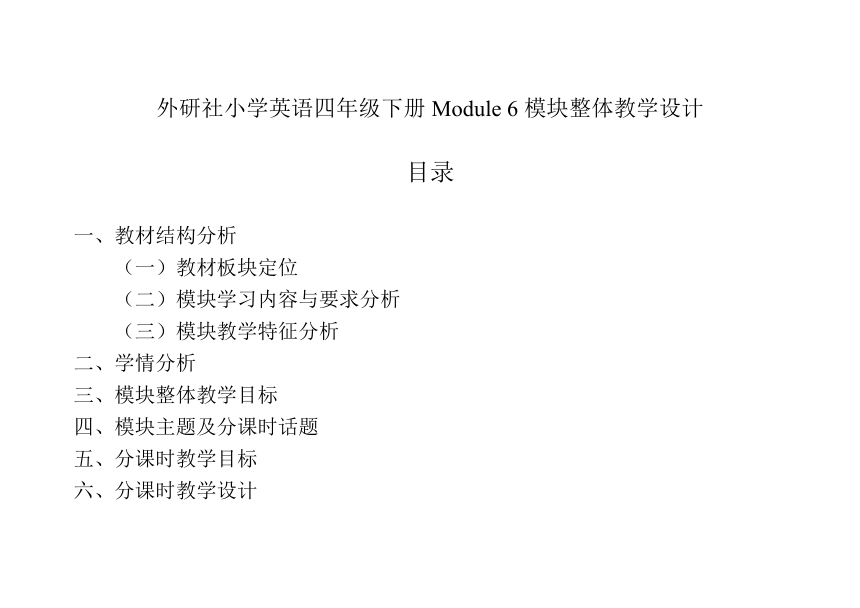
|
|
| 格式 | docx | ||
| 文件大小 | 5.1MB | ||
| 资源类型 | 教案 | ||
| 版本资源 | 外研版(三年级起点) | ||
| 科目 | 英语 | ||
| 更新时间 | 2022-07-08 09:35:51 | ||
图片预览

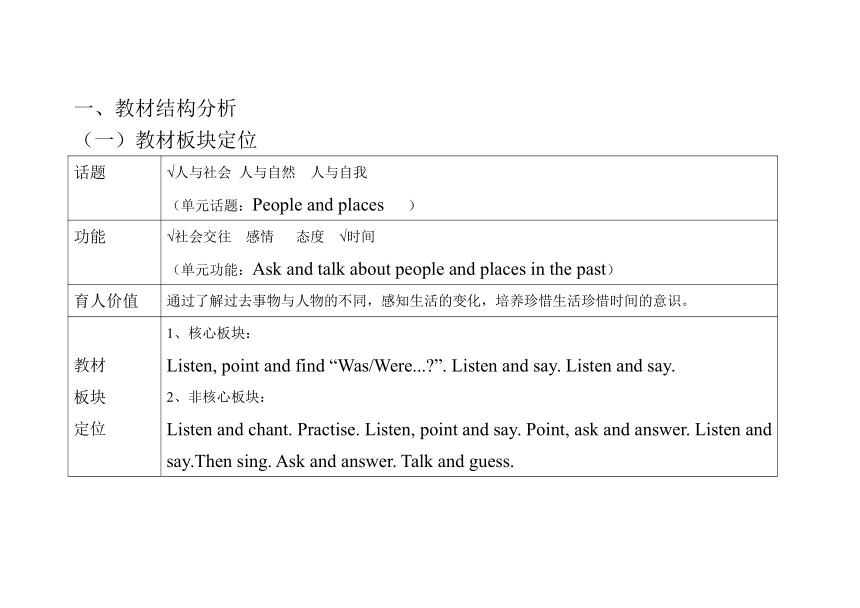
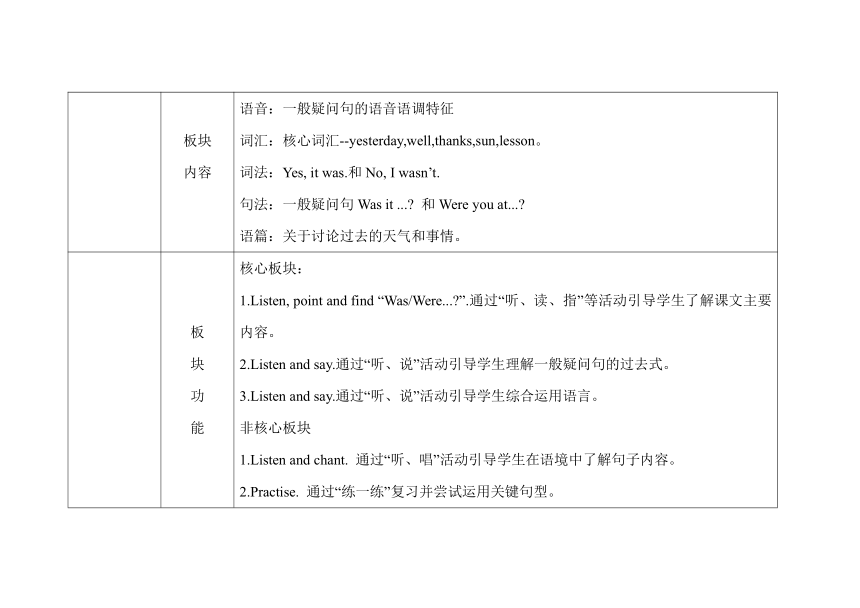
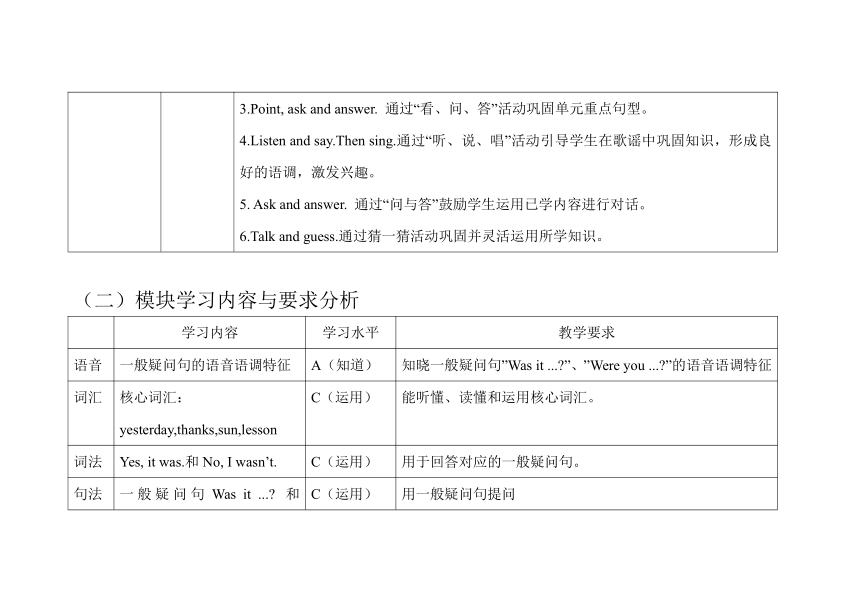
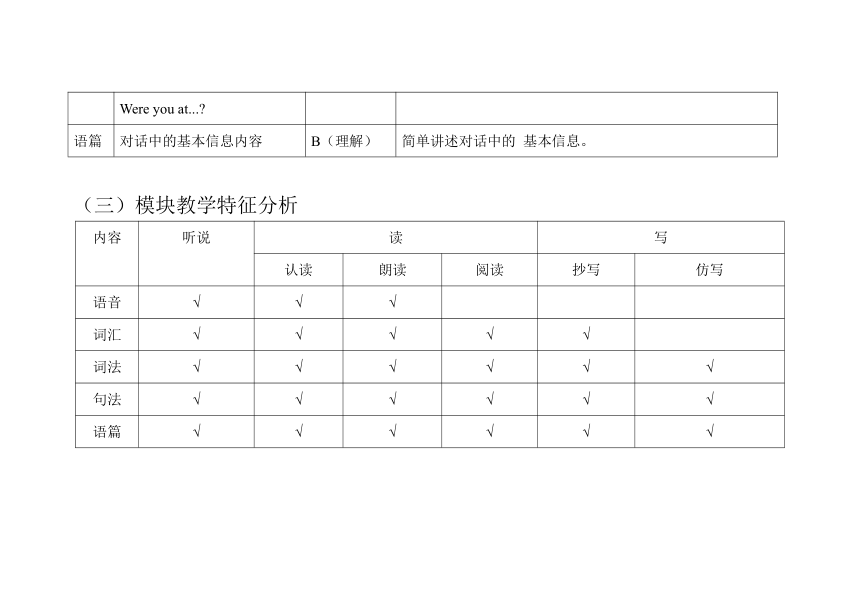
文档简介
外研社小学英语四年级下册Module 6模块整体教学设计
目录
教材结构分析
(一)教材板块定位
(二)模块学习内容与要求分析
(三)模块教学特征分析
学情分析
模块整体教学目标
模块主题及分课时话题
分课时教学目标
分课时教学设计
教材结构分析
(一)教材板块定位
话题 √人与社会 人与自然 人与自我 (单元话题:People and places )
功能 √社会交往 感情 态度 √时间 (单元功能:Ask and talk about people and places in the past)
育人价值 通过了解过去事物与人物的不同,感知生活的变化,培养珍惜生活珍惜时间的意识。
教材 板块 定位 1、核心板块: Listen, point and find “Was/Were... ”. Listen and say. Listen and say. 2、非核心板块: Listen and chant. Practise. Listen, point and say. Point, ask and answer. Listen and say.Then sing. Ask and answer. Talk and guess.
板块 内容 语音:一般疑问句的语音语调特征 词汇:核心词汇--yesterday,well,thanks,sun,lesson。 词法:Yes, it was.和No, I wasn’t. 句法:一般疑问句Was it ... 和Were you at... 语篇:关于讨论过去的天气和事情。
板 块 功 能 核心板块: 1.Listen, point and find “Was/Were... ”.通过“听、读、指”等活动引导学生了解课文主要内容。 2.Listen and say.通过“听、说”活动引导学生理解一般疑问句的过去式。 3.Listen and say.通过“听、说”活动引导学生综合运用语言。 非核心板块 1.Listen and chant. 通过“听、唱”活动引导学生在语境中了解句子内容。 2.Practise. 通过“练一练”复习并尝试运用关键句型。 3.Point, ask and answer. 通过“看、问、答”活动巩固单元重点句型。 4.Listen and say.Then sing.通过“听、说、唱”活动引导学生在歌谣中巩固知识,形成良好的语调,激发兴趣。 5. Ask and answer. 通过“问与答”鼓励学生运用已学内容进行对话。 6.Talk and guess.通过猜一猜活动巩固并灵活运用所学知识。
(二)模块学习内容与要求分析
学习内容 学 教学要求
语音 一般疑问句的语音语调特征 A(知道) 知晓一般疑问句”Was it ... ”、”Were you ... ”的语音语调特征
词汇 核心词汇:yesterday,thanks,sun,lesson C(运用) 能听懂、读懂和运用核心词汇。
词法 Yes, it was.和No, I wasn’t. C(运用) 用于回答对应的一般疑问句。
句法 一般疑问句Was it ... 和Were you at... C(运用) 用一般疑问句提问
语篇 对话中的基本信息内容 B(理解) 简单讲述对话中的 基本信息。
(三)模块教学特征分析
内容 听说 读 写
认读 朗读 阅读 抄写 仿写
语音 √ √ √
词汇 √ √ √ √ √
词法 √ √ √ √ √ √
句法 √ √ √ √ √ √
语篇 √ √ √ √ √ √
二、学情分析
本课的教学对象是四年级学生,经过一年的英语学习,大部分学生具备较好的英语理解能力,能积极参与到课堂中,能在教师引导下进行语言表达,同时能通过两人讨论及小组合作完成学习任务。
通过学情分析,对“教学内容、学生呢学习基础及相关活动选择进行梳理(如下表):
内容 知识要点 教材栏目 学生基础
语音 一般疑问句的语音语调特征 Listen and chant. 熟知 √略知
词汇 核心词汇:yesterday,thanks,sun,lesson Listen, point and find “Was/Were... ”. 熟知 √略知
词法 Yes, it was.和No, I wasn’t. Listen and say. 熟知 √略知
句法 一般疑问句Was it ... 和Were you at... Listen, point and say. 熟知 √略知
语篇 对话中的基本信息内容 Listen, point and find “Was/Were... ”. Listen and say. 熟知 略知
三、模块整体教学目标
(一)语言能力
1.知晓一般疑问句”Was it ... ”、”Were you ... ”的语音语调特征,并能模仿朗读。
2.看懂、听懂、理解并运用核心词汇:yesterday,thanks,sun,lesson。
3.运用句型”Was it ... ”、”Were you ... ”谈论过去的天气及人物在哪里。
4.运用阅读策略读懂、理解相关语篇,获取基本信息,模仿语言结构谈论过去的天气及人物在哪里。
(二)学习能力
1.在课堂学习和交流中,注意倾听,积极表达。通过模仿、阅读、思考、讨论等方式,完成学习任务。
2.能够运用阅读策略自主阅读并总结有效的学习方法。
3.学会对学习过程和成果进行总结、反思、自我评价。
(三)文化意识
1.树立关注天气、关心身边环境变化的意识。
2.了解“西方人习惯谈论天气”的习惯和文化。
3.进一步了解英语国家人们的日常活动。
(四)思维品质
1.运用阅读策略读懂、理解相关语篇,获取基本信息,模仿语言结构谈论过去的天气及人物在哪里。
四、模块主题及分课时话题
单元 话题 情境 功能 分课时
Unit 1 People weather Sam和Grandma 谈论过去的天气以及在哪里。 谈论过去与现在的天气以及过去与现在人在哪里。 Period 1:Learning and speaking
Period 2: Listening and speaking
Unit 2 place Lingling和Amy谈论深圳的变化和发展。 谈论某个地方过去与现在的变化。 Period 3: Reading and language in use
Period 4: Evaluation and improvement
五、分课时教学目标
第1课时 知识与技能 掌握单词yesterday, out, well,thanks; 能听懂和说出含有”were/was”来询问过去的行为或事件的句型及相关的回答。 感知一般疑问句的语音语调特质。
过程与方法 讲授法、讨论法、练习巩固法
情感态度与价值观 在游戏与问答的过程中培养学生的语言运用能力,在互相询问交流中培养关心他人的良好品质。
第2课时 知识与技能 看懂、听懂、理解并运用核心词汇:yesterday,thanks,sun,lesson。 学会运用“Were you ...?”和答句“Yes, I was./No, I wasn’t.”以及“Was it … ”和答句“Yes, it was./No, it wasn’t.”用于询问和回答过去的人物、事物或天气状态的句型。 学生能在插图的帮助下理解故事的主要内容,朗读故事人物的对话。
过程与方法 任务型阅读法、练习巩固法、讲演结合法
情感态度与价值观 培养学生关爱家人的美好品德。 在游戏与问答的过程中培养学生的语言运用能力,敢于开口,表达中不怕出现错误。
第3课时 知识与技能 1、掌握重点词汇:village 2、学习重点句型: Was it a big city then Yes, it was. /No, it wasn’t. 3、能够运用由Was 引导的一般疑问句及其回答。
过程与方法 任务型阅读法、讨论法
情感态度与价值观 培养学生根据事物的特征进行合理判断的能力。
第4课时 知识与技能 1.掌握重点词汇: clean, hometown。 2.巩固重点句型: Was it... 及其回答 Yes, it was. / No, it wasn’t. 3.能够运用Was句型来描述家乡过去的模样。
过程与方法 任务型阅读法、练习巩固法、情境表演法
情感态度与价值观 培养学生热爱家乡和热爱伟大祖国的情怀。
六、分课时教学设计
1、第1课时
教学环节 教师活动 学生活动 活动意图 备注 (活动时间)
Preparation 1.Greetings. 2.创设情境:多啦A梦与大雄坐上时光机去往“昨天”的伦敦。Let’s sing. 3.Review the words of weather. 4.Ask and answer:出示天气的图片并提问。 1.Greetings. 2.Sing the song together. 3.Say the words about weather. 4.Ask and answer: 看图回答老师关于天气的问题。 师生互动。 通过歌谣How’s the weather 引入课文学习。 复习关于天气的单词。 复习关于天气的问答并引入新课学习。 8 minutes
Presentation 出示主角人物:Tom’s grandma并介绍,同时提问“How’s the weather ” 聊天引出新句子”I want to play in the sun.” 根据情景引出句子We'll go out for our Chinese lesson. 翻动日历,引出”yesterday”的概念,并学习单词。 讲授用be动词的过去式Was/Were进行一般疑问句的提问。 根据人物和图片回答问题”It’s sunny.” 学习句子”I want to play in the sun.” 学习句子We'll go out for our Chinese lesson.以及新单词Chinese lesson。 学习单词”yesterday”。 学习用be动词的过去式Was/Were进行一般疑问句的提问。 1.建立Tom’s grandma和Grandpa在家里对话的情景,让学生在情景中学习新知识。 能听说读本课核心句子。 能听说读本课核心短语和句子。 掌握新单词。 5.通过练习巩固be动词的过去式Was/Were一般疑问句的用法。 12 minutes
Practice 出示图片,并提问。 引导学生进行Pair work活动。 Let’s chant. 4.Sharp eyes:读单词。 看图问答,练习句型。 2.学生两人一组进行对话问答。 3.Chant together. 4.Sharp eyes:读单词。 看图回答、两人对话、歌谣、Sharp eyes等活动,达到巩固练习本课学习的新单词和句型的目的。 10 minutes
Production 设置任务练习:大雄跌入时光隧道,请学生完成通关任务救大雄。 完成通关任务练习。 通过通关任务的练习,让学生进行本课时学习内容的输出,检验教学目标的实现。 8 minutes
Summary and homework 引导学生总结本课所学。 2.布置课后作业:Talk to your friends about the weather of yesterday and today. 1.学生自主总结回忆本课所学内容。 2.完成作业。 2 minutes
Blackboard Design
2、第2课时
教学环节 教师活动 学生活动 活动意图 备注 (活动时间)
Preparation Greetings. 创设情境:多啦A梦和大雄继续进行时空旅行,回到Tom的家。 3.Play a game .“冲破云层”复习第1课时的单词。 4.Guide students to chant.复习第一课时天气的单词和is,was 的用法 Ask students to look at the pictures and ask or answer by using the sentences patterns: Greetings. Look at some pictures. 3.Play a game to consolidate the new words. 4. Chant together. 5. Look at the pictures and ask or answer by using the sentences patterns: Was it… Yes, it was./No, it wasn’t. 1.拉近师生距离。 2.由创设的情境,引出教学内容。 3.用游戏“冲破云层”复习新单词。 4.通过歌曲“旅行之歌”复习所学内容。 5.通过看图回答的方式复习巩固was,were的用法。 10 minutes
Presentation 1.Play a video and guide students to chant. 学习Unit1 的Activity1内容。 2.Review the the sentences patterns. 3.Let students watch the video and answer the questions: What are they doing 4.Let students watch the video for the second time, listen and fill in the blanks. 5.Let students watch the video the third time and answer the questions: a. Was grandma at home b. Are you at home now, grandma 1. Enjoy the video and chant together. 2. Review the the sentences patterns. 3.Listen to the tape carefully and choose the picture. 4. Listen to the tape carefully for the second time and fill in the blanks. 5. Students watch the video the third time and answer the questions: 1.通过看视频和唱歌激发学生的学习兴趣。 2.通过角色人物对话,复习上一课的句子,同时引出本课的教学内容。 3.学习课文,理解课文,熟练课文。 10 minutes
Practice Let students watch the video, listen and read after the video. 2.Let students read the text together. 3.Let students do the pair work. 4.Let students role play in groups and invite some groups to act it out. 1. Watch the video, listen and read after the video. 2. The whole class read the text together. 3. Do the pair work. 4. Role play in groups and then come to the stage to act out. 通过听课文、跟读课文,自由读,角色扮演等活动,达到熟悉和巩固课文的效果。 10 minutes
Production Let the students finish the multiple choice. Let the students make a dialogue in groups. 1. Finish the multiple choice. 2. Make a dialogue in groups and practice it and then act it out. 对课文内容进行巩固,并进行语言的输出,能运用自己的语言把课堂的知识融合。 6 minutes
Summary and homework 1.Sum up the key words and sentence patterns in this lesson. 2.引导学生: If you love your grandparents,please let them know. Homework: 1.Read the key words and sentences of this lesson. 2.Try to love others. 3.Finish the homework. 1.总结归纳本课时所学内容。 2.对学生进行情感教育。 4 minutes
Blackboard Design
第3课时
教学环节 教师活动 学生活动 活动意图 备注 (活动时间)
Preparation 1.Greetings. 2.Review the words. 3.Play a game 复习几组形容词反义词的单词。 Have a chant. 1.Greetings. 2.Say the words. 3.Ask and answer. 4.Chant together 1.师生互动。 2.通过游戏复习单词。 3.复习形容词反义词的单词。 4.让学生先形成前后对比意识。 8 minutes
Presentation 出示深圳的照片引出句子Was it a big city then 2.Watch a video about Shenzhen.教授新单词village。 3.问答引出句子:It was…then./It is…now. 4.Watch the video in activity 2然后跟读齐读课文。 1.思考问题。 2.学习新单词village。 3.学习句子It was…then./It is …now. 4.感知课文对话内容然后跟读齐读课文。 1.建立Amy和Lingling在看相册对话谈到深圳变化的情景,让学生在情景中学习新知识。 2.通过对三组图片的描述,巩固句子It was…then./It is …now. 的用法。 14 minutes
Practice 1.补全句子(出示两组前后不同的图片) 然后出示一组照片让学生用“It was…then./It is …now.进行对比描述。 2.出示图片,用Was it/Were they... 问答引导学生进行Pair work活动。 1.观察图片描述过去和现在的状态。练习句型: It was…then./ It is …now. 2.看图问答,练习句型。然后两人一小组互相问答。 通过看图回答、两人对话等活动,达到巩固练习本课学习的新单词和句型的目的。 8 minutes
Production 1.Let’s chant. 2.出示be动词的变化,同时出示练习。 1.Chant together. 2.完成学习任务和练习。 通过歌谣、学习任务和练习,让学生进行本课时学习内容的输出,检验教学目标的实现。 8 minutes
Summary and homework 1.引导学生总结本课所学。 2.布置课后作业: 1.学生自主总结回忆本课所学内容。 2.完成作业。 通过描述家乡让学生感受家乡的变化。 2 minutes
Blackboard Design
4、第4课时
教学环节 教师活动 学生活动 活动意图 备注(活动时间)
Preparation 1.Greetings. 2.Play a game: Shoot planes.(复习旧单词) 3.Watch a video:Maoming. 4.Describe the cover. 5. Ask and answer. 1.Greetings. 2.Read the words quickly. 3. Watch a video:Maoming. 4.Answer the title of the book. 5. Answer questions. 1.拉近师生距离。 2.通过Shoot planes的游戏,复习所学单词。 3.通过观看茂名变化的视频,导入本课主题village。 4.通过看绘本封面回答标题的方式吸引学生的兴趣。 6 minutes
Presentation 1.Watch and answer. Was it big 2.Read and answer (Part 1) Where did I live Was it big Was it clean Was it beautiful 3.Listen and answer. (Part 2) Q: What about now 1.Answer. No, it wasn’t. 2.Read and answer 1) A small village. 2) No, it wasn’t. 3) No, it wasn’t. 4) No, it wasn’t. 3.Listen and answer. Now it’s big. It’s clean. It’s beautiful. 通过观看绘本视频,整体理解绘本。2.分部分阅读,能层层剖析绘本内容,一步步将学生引导到绘本的情境当中,也进一步吸引学生的注意力和回答问题的积极性。 3.通过What about now 这个情境的设置,并附带听力音频,让学生去感知,现在的茂名和过去的强烈对比。 15 minutes
Practice Pair work(和同桌一问一答,扮演对话)。 Repeat. Retell the story! Pair work(和同桌一问一答,扮演对话)。 Read after it. Retell the story! 通过扮演绘本对话,激发学生爱表演的天性。 跟读课文,语音语调达到进一步提高。 通过复述绘本,巩固课文的效果。 10 minutes
Production Stick and say! Stick and say! 通过粘贴绘本中自己最印象深刻的图,并快速描述出来,达到对绘本的进一步提升与巩固。 5 minutes
Summary and homework Let students summarize what we have learned. Emotional education: Homework: Summarize what we have learned. Care about our hometown. Finish the homework. 通过总结梳理绘本内容学生对绘本的故事有了深刻的理解。 通过情感教育,增进学生热爱家乡的情感。 4 minutes
Blackboard Design
目录
教材结构分析
(一)教材板块定位
(二)模块学习内容与要求分析
(三)模块教学特征分析
学情分析
模块整体教学目标
模块主题及分课时话题
分课时教学目标
分课时教学设计
教材结构分析
(一)教材板块定位
话题 √人与社会 人与自然 人与自我 (单元话题:People and places )
功能 √社会交往 感情 态度 √时间 (单元功能:Ask and talk about people and places in the past)
育人价值 通过了解过去事物与人物的不同,感知生活的变化,培养珍惜生活珍惜时间的意识。
教材 板块 定位 1、核心板块: Listen, point and find “Was/Were... ”. Listen and say. Listen and say. 2、非核心板块: Listen and chant. Practise. Listen, point and say. Point, ask and answer. Listen and say.Then sing. Ask and answer. Talk and guess.
板块 内容 语音:一般疑问句的语音语调特征 词汇:核心词汇--yesterday,well,thanks,sun,lesson。 词法:Yes, it was.和No, I wasn’t. 句法:一般疑问句Was it ... 和Were you at... 语篇:关于讨论过去的天气和事情。
板 块 功 能 核心板块: 1.Listen, point and find “Was/Were... ”.通过“听、读、指”等活动引导学生了解课文主要内容。 2.Listen and say.通过“听、说”活动引导学生理解一般疑问句的过去式。 3.Listen and say.通过“听、说”活动引导学生综合运用语言。 非核心板块 1.Listen and chant. 通过“听、唱”活动引导学生在语境中了解句子内容。 2.Practise. 通过“练一练”复习并尝试运用关键句型。 3.Point, ask and answer. 通过“看、问、答”活动巩固单元重点句型。 4.Listen and say.Then sing.通过“听、说、唱”活动引导学生在歌谣中巩固知识,形成良好的语调,激发兴趣。 5. Ask and answer. 通过“问与答”鼓励学生运用已学内容进行对话。 6.Talk and guess.通过猜一猜活动巩固并灵活运用所学知识。
(二)模块学习内容与要求分析
学习内容 学 教学要求
语音 一般疑问句的语音语调特征 A(知道) 知晓一般疑问句”Was it ... ”、”Were you ... ”的语音语调特征
词汇 核心词汇:yesterday,thanks,sun,lesson C(运用) 能听懂、读懂和运用核心词汇。
词法 Yes, it was.和No, I wasn’t. C(运用) 用于回答对应的一般疑问句。
句法 一般疑问句Was it ... 和Were you at... C(运用) 用一般疑问句提问
语篇 对话中的基本信息内容 B(理解) 简单讲述对话中的 基本信息。
(三)模块教学特征分析
内容 听说 读 写
认读 朗读 阅读 抄写 仿写
语音 √ √ √
词汇 √ √ √ √ √
词法 √ √ √ √ √ √
句法 √ √ √ √ √ √
语篇 √ √ √ √ √ √
二、学情分析
本课的教学对象是四年级学生,经过一年的英语学习,大部分学生具备较好的英语理解能力,能积极参与到课堂中,能在教师引导下进行语言表达,同时能通过两人讨论及小组合作完成学习任务。
通过学情分析,对“教学内容、学生呢学习基础及相关活动选择进行梳理(如下表):
内容 知识要点 教材栏目 学生基础
语音 一般疑问句的语音语调特征 Listen and chant. 熟知 √略知
词汇 核心词汇:yesterday,thanks,sun,lesson Listen, point and find “Was/Were... ”. 熟知 √略知
词法 Yes, it was.和No, I wasn’t. Listen and say. 熟知 √略知
句法 一般疑问句Was it ... 和Were you at... Listen, point and say. 熟知 √略知
语篇 对话中的基本信息内容 Listen, point and find “Was/Were... ”. Listen and say. 熟知 略知
三、模块整体教学目标
(一)语言能力
1.知晓一般疑问句”Was it ... ”、”Were you ... ”的语音语调特征,并能模仿朗读。
2.看懂、听懂、理解并运用核心词汇:yesterday,thanks,sun,lesson。
3.运用句型”Was it ... ”、”Were you ... ”谈论过去的天气及人物在哪里。
4.运用阅读策略读懂、理解相关语篇,获取基本信息,模仿语言结构谈论过去的天气及人物在哪里。
(二)学习能力
1.在课堂学习和交流中,注意倾听,积极表达。通过模仿、阅读、思考、讨论等方式,完成学习任务。
2.能够运用阅读策略自主阅读并总结有效的学习方法。
3.学会对学习过程和成果进行总结、反思、自我评价。
(三)文化意识
1.树立关注天气、关心身边环境变化的意识。
2.了解“西方人习惯谈论天气”的习惯和文化。
3.进一步了解英语国家人们的日常活动。
(四)思维品质
1.运用阅读策略读懂、理解相关语篇,获取基本信息,模仿语言结构谈论过去的天气及人物在哪里。
四、模块主题及分课时话题
单元 话题 情境 功能 分课时
Unit 1 People weather Sam和Grandma 谈论过去的天气以及在哪里。 谈论过去与现在的天气以及过去与现在人在哪里。 Period 1:Learning and speaking
Period 2: Listening and speaking
Unit 2 place Lingling和Amy谈论深圳的变化和发展。 谈论某个地方过去与现在的变化。 Period 3: Reading and language in use
Period 4: Evaluation and improvement
五、分课时教学目标
第1课时 知识与技能 掌握单词yesterday, out, well,thanks; 能听懂和说出含有”were/was”来询问过去的行为或事件的句型及相关的回答。 感知一般疑问句的语音语调特质。
过程与方法 讲授法、讨论法、练习巩固法
情感态度与价值观 在游戏与问答的过程中培养学生的语言运用能力,在互相询问交流中培养关心他人的良好品质。
第2课时 知识与技能 看懂、听懂、理解并运用核心词汇:yesterday,thanks,sun,lesson。 学会运用“Were you ...?”和答句“Yes, I was./No, I wasn’t.”以及“Was it … ”和答句“Yes, it was./No, it wasn’t.”用于询问和回答过去的人物、事物或天气状态的句型。 学生能在插图的帮助下理解故事的主要内容,朗读故事人物的对话。
过程与方法 任务型阅读法、练习巩固法、讲演结合法
情感态度与价值观 培养学生关爱家人的美好品德。 在游戏与问答的过程中培养学生的语言运用能力,敢于开口,表达中不怕出现错误。
第3课时 知识与技能 1、掌握重点词汇:village 2、学习重点句型: Was it a big city then Yes, it was. /No, it wasn’t. 3、能够运用由Was 引导的一般疑问句及其回答。
过程与方法 任务型阅读法、讨论法
情感态度与价值观 培养学生根据事物的特征进行合理判断的能力。
第4课时 知识与技能 1.掌握重点词汇: clean, hometown。 2.巩固重点句型: Was it... 及其回答 Yes, it was. / No, it wasn’t. 3.能够运用Was句型来描述家乡过去的模样。
过程与方法 任务型阅读法、练习巩固法、情境表演法
情感态度与价值观 培养学生热爱家乡和热爱伟大祖国的情怀。
六、分课时教学设计
1、第1课时
教学环节 教师活动 学生活动 活动意图 备注 (活动时间)
Preparation 1.Greetings. 2.创设情境:多啦A梦与大雄坐上时光机去往“昨天”的伦敦。Let’s sing. 3.Review the words of weather. 4.Ask and answer:出示天气的图片并提问。 1.Greetings. 2.Sing the song together. 3.Say the words about weather. 4.Ask and answer: 看图回答老师关于天气的问题。 师生互动。 通过歌谣How’s the weather 引入课文学习。 复习关于天气的单词。 复习关于天气的问答并引入新课学习。 8 minutes
Presentation 出示主角人物:Tom’s grandma并介绍,同时提问“How’s the weather ” 聊天引出新句子”I want to play in the sun.” 根据情景引出句子We'll go out for our Chinese lesson. 翻动日历,引出”yesterday”的概念,并学习单词。 讲授用be动词的过去式Was/Were进行一般疑问句的提问。 根据人物和图片回答问题”It’s sunny.” 学习句子”I want to play in the sun.” 学习句子We'll go out for our Chinese lesson.以及新单词Chinese lesson。 学习单词”yesterday”。 学习用be动词的过去式Was/Were进行一般疑问句的提问。 1.建立Tom’s grandma和Grandpa在家里对话的情景,让学生在情景中学习新知识。 能听说读本课核心句子。 能听说读本课核心短语和句子。 掌握新单词。 5.通过练习巩固be动词的过去式Was/Were一般疑问句的用法。 12 minutes
Practice 出示图片,并提问。 引导学生进行Pair work活动。 Let’s chant. 4.Sharp eyes:读单词。 看图问答,练习句型。 2.学生两人一组进行对话问答。 3.Chant together. 4.Sharp eyes:读单词。 看图回答、两人对话、歌谣、Sharp eyes等活动,达到巩固练习本课学习的新单词和句型的目的。 10 minutes
Production 设置任务练习:大雄跌入时光隧道,请学生完成通关任务救大雄。 完成通关任务练习。 通过通关任务的练习,让学生进行本课时学习内容的输出,检验教学目标的实现。 8 minutes
Summary and homework 引导学生总结本课所学。 2.布置课后作业:Talk to your friends about the weather of yesterday and today. 1.学生自主总结回忆本课所学内容。 2.完成作业。 2 minutes
Blackboard Design
2、第2课时
教学环节 教师活动 学生活动 活动意图 备注 (活动时间)
Preparation Greetings. 创设情境:多啦A梦和大雄继续进行时空旅行,回到Tom的家。 3.Play a game .“冲破云层”复习第1课时的单词。 4.Guide students to chant.复习第一课时天气的单词和is,was 的用法 Ask students to look at the pictures and ask or answer by using the sentences patterns: Greetings. Look at some pictures. 3.Play a game to consolidate the new words. 4. Chant together. 5. Look at the pictures and ask or answer by using the sentences patterns: Was it… Yes, it was./No, it wasn’t. 1.拉近师生距离。 2.由创设的情境,引出教学内容。 3.用游戏“冲破云层”复习新单词。 4.通过歌曲“旅行之歌”复习所学内容。 5.通过看图回答的方式复习巩固was,were的用法。 10 minutes
Presentation 1.Play a video and guide students to chant. 学习Unit1 的Activity1内容。 2.Review the the sentences patterns. 3.Let students watch the video and answer the questions: What are they doing 4.Let students watch the video for the second time, listen and fill in the blanks. 5.Let students watch the video the third time and answer the questions: a. Was grandma at home b. Are you at home now, grandma 1. Enjoy the video and chant together. 2. Review the the sentences patterns. 3.Listen to the tape carefully and choose the picture. 4. Listen to the tape carefully for the second time and fill in the blanks. 5. Students watch the video the third time and answer the questions: 1.通过看视频和唱歌激发学生的学习兴趣。 2.通过角色人物对话,复习上一课的句子,同时引出本课的教学内容。 3.学习课文,理解课文,熟练课文。 10 minutes
Practice Let students watch the video, listen and read after the video. 2.Let students read the text together. 3.Let students do the pair work. 4.Let students role play in groups and invite some groups to act it out. 1. Watch the video, listen and read after the video. 2. The whole class read the text together. 3. Do the pair work. 4. Role play in groups and then come to the stage to act out. 通过听课文、跟读课文,自由读,角色扮演等活动,达到熟悉和巩固课文的效果。 10 minutes
Production Let the students finish the multiple choice. Let the students make a dialogue in groups. 1. Finish the multiple choice. 2. Make a dialogue in groups and practice it and then act it out. 对课文内容进行巩固,并进行语言的输出,能运用自己的语言把课堂的知识融合。 6 minutes
Summary and homework 1.Sum up the key words and sentence patterns in this lesson. 2.引导学生: If you love your grandparents,please let them know. Homework: 1.Read the key words and sentences of this lesson. 2.Try to love others. 3.Finish the homework. 1.总结归纳本课时所学内容。 2.对学生进行情感教育。 4 minutes
Blackboard Design
第3课时
教学环节 教师活动 学生活动 活动意图 备注 (活动时间)
Preparation 1.Greetings. 2.Review the words. 3.Play a game 复习几组形容词反义词的单词。 Have a chant. 1.Greetings. 2.Say the words. 3.Ask and answer. 4.Chant together 1.师生互动。 2.通过游戏复习单词。 3.复习形容词反义词的单词。 4.让学生先形成前后对比意识。 8 minutes
Presentation 出示深圳的照片引出句子Was it a big city then 2.Watch a video about Shenzhen.教授新单词village。 3.问答引出句子:It was…then./It is…now. 4.Watch the video in activity 2然后跟读齐读课文。 1.思考问题。 2.学习新单词village。 3.学习句子It was…then./It is …now. 4.感知课文对话内容然后跟读齐读课文。 1.建立Amy和Lingling在看相册对话谈到深圳变化的情景,让学生在情景中学习新知识。 2.通过对三组图片的描述,巩固句子It was…then./It is …now. 的用法。 14 minutes
Practice 1.补全句子(出示两组前后不同的图片) 然后出示一组照片让学生用“It was…then./It is …now.进行对比描述。 2.出示图片,用Was it/Were they... 问答引导学生进行Pair work活动。 1.观察图片描述过去和现在的状态。练习句型: It was…then./ It is …now. 2.看图问答,练习句型。然后两人一小组互相问答。 通过看图回答、两人对话等活动,达到巩固练习本课学习的新单词和句型的目的。 8 minutes
Production 1.Let’s chant. 2.出示be动词的变化,同时出示练习。 1.Chant together. 2.完成学习任务和练习。 通过歌谣、学习任务和练习,让学生进行本课时学习内容的输出,检验教学目标的实现。 8 minutes
Summary and homework 1.引导学生总结本课所学。 2.布置课后作业: 1.学生自主总结回忆本课所学内容。 2.完成作业。 通过描述家乡让学生感受家乡的变化。 2 minutes
Blackboard Design
4、第4课时
教学环节 教师活动 学生活动 活动意图 备注(活动时间)
Preparation 1.Greetings. 2.Play a game: Shoot planes.(复习旧单词) 3.Watch a video:Maoming. 4.Describe the cover. 5. Ask and answer. 1.Greetings. 2.Read the words quickly. 3. Watch a video:Maoming. 4.Answer the title of the book. 5. Answer questions. 1.拉近师生距离。 2.通过Shoot planes的游戏,复习所学单词。 3.通过观看茂名变化的视频,导入本课主题village。 4.通过看绘本封面回答标题的方式吸引学生的兴趣。 6 minutes
Presentation 1.Watch and answer. Was it big 2.Read and answer (Part 1) Where did I live Was it big Was it clean Was it beautiful 3.Listen and answer. (Part 2) Q: What about now 1.Answer. No, it wasn’t. 2.Read and answer 1) A small village. 2) No, it wasn’t. 3) No, it wasn’t. 4) No, it wasn’t. 3.Listen and answer. Now it’s big. It’s clean. It’s beautiful. 通过观看绘本视频,整体理解绘本。2.分部分阅读,能层层剖析绘本内容,一步步将学生引导到绘本的情境当中,也进一步吸引学生的注意力和回答问题的积极性。 3.通过What about now 这个情境的设置,并附带听力音频,让学生去感知,现在的茂名和过去的强烈对比。 15 minutes
Practice Pair work(和同桌一问一答,扮演对话)。 Repeat. Retell the story! Pair work(和同桌一问一答,扮演对话)。 Read after it. Retell the story! 通过扮演绘本对话,激发学生爱表演的天性。 跟读课文,语音语调达到进一步提高。 通过复述绘本,巩固课文的效果。 10 minutes
Production Stick and say! Stick and say! 通过粘贴绘本中自己最印象深刻的图,并快速描述出来,达到对绘本的进一步提升与巩固。 5 minutes
Summary and homework Let students summarize what we have learned. Emotional education: Homework: Summarize what we have learned. Care about our hometown. Finish the homework. 通过总结梳理绘本内容学生对绘本的故事有了深刻的理解。 通过情感教育,增进学生热爱家乡的情感。 4 minutes
Blackboard Design
同课章节目录
- Module 1
- Unit 1 She's a nice teache
- Unit 2 He's cool.
- Module 2
- Unit 1 London is a big city.
- Unit 2 It's very old.
- Module 3
- Unit 1 Robots will do everything.
- Unit 2 On Monday I'll go swimming.
- Module 4
- Unit 1 Will you take your kite?
- Unit 2 Will it be hot in Haikou?
- Module 5
- Unit 1 I was two then.
- Unit 2 They were young.
- Module 6
- Unit 1 Were you at home yesterday?
- Unit 2 Was it a big city then ?
- Module 7
- Unit 1 I helped Mum.
- Unit 2 Grandma cooked fish.
- Module 8
- Unit 1 They sang beautifully.
- Unit 2 I took some pictures.
- Module 9
- Unit 1 Did he live in New York ?
- Unit 2 Did you have a nice holiday?
- Review Module
- Unit 1
- Unit 2
- Module 10
- Unit 1 Did you fall off your bike?
- Unit 2 Sam had lots of chocolate.
